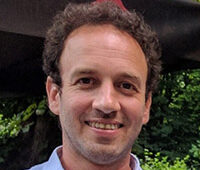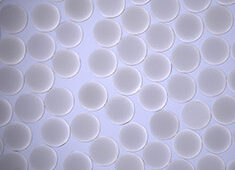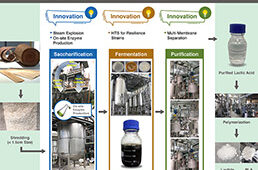Dr. Kristan Gurton, an experimental physicist in the Battlefield Environmental Division, Computational and Information Sciences Directorate, U.S. Army Research Laboratory, conducts experiments. Photo courtesy U.S. Army Research Laboratory. |
To
warn of chemical attacks and help save lives, it’s vital to quickly
determine if even trace levels of potentially deadly chemicals—such as
the nerve gas sarin and other odorless, colorless agents—are present.
U.S. Army researchers have developed a new chemical sensor that can
simultaneously identify a potentially limitless numbers of agents, in
real time. A paper describing the system has been published this week in
the Optical Society’s (OSA) journal, Optics Letters.
The
new system is based on a phenomenon known as the photoacoustic effect,
which was discovered by Alexander Graham Bell, in which the absorption
of light by materials generates characteristic acoustic waves. By using a
laser and very sensitive microphones—in a technique called laser
photoacoustic spectroscopy (LPAS)—vanishingly low concentrations of
gases, at parts per billion or even parts per trillion levels, can be
detected. The drawback of traditional LPAS systems, however, is that
they can identify only one chemical at a time.
“Photoacoustics
is an excellent analytic tool, but is somewhat limited in the sense
that one traditionally only measures one absorption parameter at a
time,” says Kristan Gurton, an experimental physicist at the U.S. Army
Research Laboratory (ARL) in Adelphi, Md. “As I started looking into the
chemical/biological detection problem, it became apparent that multiple
LPAS absorption measurements—representing an ‘absorption
spectrum’—might provide the added information required in any detection
and identification scheme.”
To
create such a multi-wavelength LPAS system, Gurton, along with
co-authors Melvin Felton and Richard Tober of the ARL, designed a sensor
known as a photoacoustic cell. This hollow, cylindrical device holds
the gas being sampled and contains microphones that can listen for the
characteristic signal when light is applied to the sample.
In
this experiment, the researchers used a specialized cell that allows
different gases to flow through the device for testing. As the vapor of
five nerve agent mimics was flowed in, three laser beams, each
modulated at a different frequency in the acoustic range, were
propagated through the cell.
“A
portion of the laser power is absorbed, usually via molecular
transitions, and this absorption results in localized heating of the
gas,” Gurton explains. Molecular transitions occur when the electrons in
a molecule are excited from one energy level to a higher energy level.
“Since gas dissipates thermal energy fairly quickly, the modulated laser
results in a rapid heat/cooling cycle that produces a faint acoustic
wave,” which is picked up by the microphone. Each laser in the system
will produce a single tone, so, for example, six laser sources have six
possible tones.
|
“Different
agents will affect the relative ‘loudness’ of each tone,” he says, “so
for one gas, some tones will be louder than others, and it is these
differences that allow for species identification.”
The
signals produced by each laser were separated using multiple “lock-in”
amplifiers—which can extract signals from noisy environments—each tuned
for a specific laser frequency. Then, by comparing the results to a
database of absorption information for a range of chemical species, the
system identified each of the five gases.
Because
it is optically based, the method allows for instant identification of
agents, as long as the signal-to-noise ratio, which depends on both
laser power and the concentration of the compound being measured, is
sufficiently high, and the material in question is in the database.
Before
a device based on the technique could be used in the field, Gurton
says, a quantum cascade (QC) laser array with at least six “well-chosen”
mid-infrared (MidIR) laser wavelengths would need to be available.
“There
are groups of researchers producing QC laser arrays that will operate
with sufficient power, and will house as many as 10—or more—lasers at
different frequencies in the spectroscopically rich region of the
MidIR,” he says.
Once
such laser arrays are available, the method ultimately “could be
tailored for a variety of detection scenarios ranging from the obvious
need to protect our soldiers during conflict to civilian applications
like detecting the presence of harmful chemical gases that are difficult
to detect with conventional techniques,” Gurton says. A sufficiently
rugged device for in-the-field use, he envisions, could be about the
size of a milk carton. “A photoacoustic cell is surprisingly simple and
inexpensive to produce, with all of the cost and size driven primarily
by the packaging of the quantum cascade laser array,” he adds.
A device based on selective real-time detection of gaseous nerve agent stimulants using multi-wavelength photoacoustics could look like this, in which now “multiple” lasers are used. Image courtesy U.S. Army Research Laboratory. |
In theory, the method could be used to identify an unlimited number of chemical agents.
“In
our paper we demonstrated the ability to measure as many identifying
absorption features as you want,” Gurton says. “You’re only limited by
the number of laser sources available.” However, he notes, “at some
point, as the number of species spectra increase in the database, a
degree of spectral overlap would occur, which might result in erroneous
identification. It just depends on how similar the spectra are to each
other. You could have just two that have very similar spectra and that
could cause problems, or you could have 20 to 30 species spectra that
all have distinguishable features that can be identified easily.”
Selective real-time detection of gaseous nerve agent simulants using multi-wavelength photoacoustics
Source: Optical Society of America







